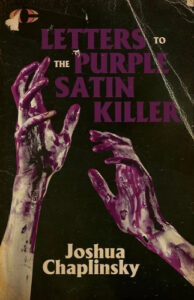Dear crime writer,
Need to breathe a little life into the bloated corpse of your narrative? Looking for a new, downwind angle from which to approach its fetid stench? Then pull on a pair of surgical gloves and prep those nibs, because the epistolary format is the break in the case you’ve been hoping for.
Epistolography lends itself to the crime genre quite nicely. I should know. I wrote my new novel as a series of missives. It’s called Letters to the Purple Satin Killer, and it explores the aftermath of a serial killer’s crimes via the correspondence he receives while on death row. It comes out August 6th through CLASH Books. Here are some of the lessons I learned while writing it.
Complicity is Caring
Say you are writing from the perspective of an irredeemable sociopath, as one does. No matter how abhorrent a character they are, you still want people to connect with them on a certain level, right? Letters are an ideal way to achieve this. Letters are personal, confidential, and intimate. Their confessional nature helps establish empathy, authority, an immediate rapport. Hell, they practically make the reader an accessory! And once you’ve won them over to the dark side, you’re free to abuse their trust to your heart’s content. Force feed them whatever disinformation you like. Because that’s another benefit to writing in the epistolary format. Letters are a great way to manipulate your vict—I mean, audience.
What, you thought that irredeemable sociopath was going to be a reliable narrator?
Here are some epistolary novels featuring a sociopathic main character that will take you on an emotional rollercoaster ride: The Collector by John Fowles, We Need to Talk About Kevin by Lionel Shriver, and The End of Alice by A.M. Homes.
All Readers are Voyeurs at Heart
Reading someone’s personal correspondence is akin to eavesdropping on a conversation. Reading their diary is like wiretapping their innermost thoughts. How about perusing someone’s medical records? It doesn’t get any more intimate than that, right? What better way to draw the reader in, allow them to truly understand your characters, than by giving them complete and unfettered access? It satisfies the voyeuristic urge without the associated ethical concerns. Because if readers are anything, they are a group that gets off on the lives of other people.
Hell, maybe your main character is an exhibitionist, letting it all hang out for the reader’s pleasure. Sure, you can have voyeurism without exhibition, but can you have exhibition without voyeurism? What would be the point?
One book that really satisfies the voyeuristic urge is The Sluts by Dennis Cooper. This masterful novel is written as a compilation of fictional posts and emails between members of an online community obsessed with the death of a sex worker named Brad. Despite literally every single character being an unreliable sock puppet, the lurid subject matter proves an inescapable trap for the scopophilicly inclined.
This Evidence Ain’t Gonna Disseminate Itself
Although they may have started out that way, the contents of the modern epistolary novel aren’t restricted to solely letters. They can include any number of textual forms, such as magazine articles, newspaper clippings, audio transcriptions, legal documents, diary entries, grocery lists—which makes them the perfect vehicle for disguising your info dumps. So instead of having the villain explain the minutiae of their evil plan to the rolled eyes of all involved, or trotting out the chief inspector to give an overview of the evidence for the benefit of the reader, you can lay everything out in a more organic, more intellectually stimulating fashion. You can make the reader part of the investigation, instead of a gawker on the sideline. It makes sense for a police file to read like the outline of a college lecture. A monologue from your main character? Not so much.
Lots of different epistolary novels have presented exposition in unique and exciting ways that go beyond the florid recitation of events via formal correspondence like in the classic mystery novel, The Documents in the Case by Dorothy L. Sayers and Robert Eustace (wherein most of the documents in question are letters). There is the fabricated dossier of The Secret History of Twin Peaks by Mark Frost; or the decoder app of Night Film by Maria Pessl, which gives the reader access to all manner of supplemental material to the story. Stephen King’s Carrie interrupts the main narrative with news reports, book excerpts, and even defamatory graffiti scratched into desks. The otherwise non-epistolary In the Lake of the Woods includes “evidence” and “hypothesis” chapters to enhance the narrative experience.
These are just a few of the reasons the epistolary format works so well in crime fiction. It is deceptive in its simplicity, yielding big emotional and thematic results. It adds a layer of realness to your writing, a non-fiction sheen, like in a mockumentary or found footage film. At the very least it gives you a change of scenery, a new sandbox to play in, which is sure to reinvigorate your work and give you a newfound sense of artistic purpose.
Good luck and enjoy!
***


















